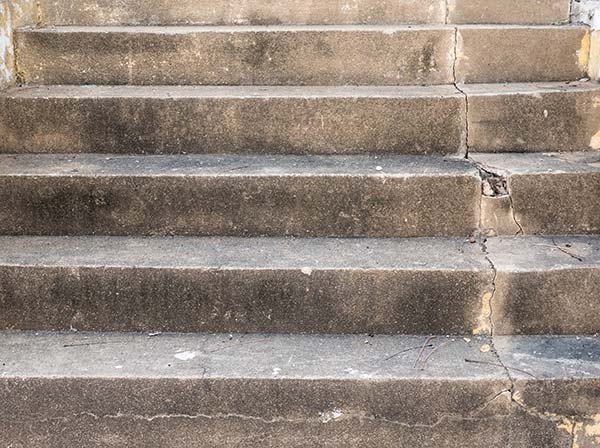Publications: Slip, Trip, and Fall
Accidents Caused by Tripping or Slipping
The insurance industry currently faces many accidents involving the victim falling for various reasons. The large majority of these occur due to slipping or tripping while walking.
Slips occur due to a foreign material on the walking surface; or due to the surface itself being slippery; and sometimes due to a combination of both.
Tripping usually occurs when the surface has an unexpected deviation or projection which catches the foot as the person steps forward. The unusual factor therein is that many of the accidents commonly identified as as “slip and falls” are actually “trip and falls” when investigated in detail. Both of these injury types are aggravated by a sudden change in level of the walking path. Hudson International has examined hundreds of such cases and measured the forensic components causing such accidents and given expert testimony thereto. Our investigative process has become more sophisticated in the last several years through the use of portable equipment which has had significant technical improvements as well as our having developed improved approaches to the investigative process with insurers and attorneys.
With over 40 years’ experience internationally as senior design architect on abroad range of projects, I have been responsible for developing buildings, walkways and cartways which meet codes and provide safe ingress and egress for the public using them. This involves thorough analysis of building construction, safety and maintenance codes along with an understanding of both the psychology and physiology of the movements of people traversing from one place to another. A significant part of this work is that of providing facilities which responsibly meet standards of the Americans with Disabilities Act.
Our approach is to review the case with the attorney or adjuster in detail prior to visiting the site , then to review applicable codes. Once that is done, we visit the site along with our client where we participate in the decision to test for a slip or a trip and fall. We measure and photograph the site of the actual fall and ensure that the conditions replicate those that existed at the time of loss. In the case of slip and falls, Hudson uses the latest tester developed to meet the stringent standards of the American Society of Testing Materials. The follow-up procedure in our offices could result in further laboratory testing of materials, additional research with manufacturers and code enforcement agencies along with other factors which might mitigate the case.
Case Studies
Hudson was retained to examine a set of new marble steps in an upscale high-rise apartment building lobby. An elderly man had apparently slipped while descending the steps and injured himself. Examination of the installation revealed that there were adequate non-slip inserts along the front of each stair tread. These projected up about 1/8″ above the step and, although they were quite slip-resistant, enabled Hudson to determine that the accident victim had caught his heel as he descended, causing him to fall forward. This was verified by a witness discovered during the site examination. The case was then treated as a trip rather than a slip. The installation also violated BOCA codes and resulted in the contractor being brought into the case as a defendant.
A woman who managed the kitchen operations for an in-store cafeteria was using a countertop hot plate to boil water for making spaghetti. When she picked up the large pot full of boiling water to bring it to the adjoining sink, she allegedly slipped as she turned, spilling the water on her legs and resulting in serious injuries. On site measurements indicated that the quarry tile floor was non-slip while dry, but slippery when wet. The degree of slipperiness suggested that if the floor was wet, it was difficult to walk on and based on that she would have become aware of this as she approached the hot plate area. The conclusion was that if the floor was wet, she would have slipped so as to spill the water on her upper body. If the floor was dry, she would have been walking on a non-slip surface. A rapid turn with an unstable open hot pot would have spilled some scalding water on her and caused her to drop the entire pot, which would inundate her lower legs and feet. This case was settled out of court.
A saleswoman delivering coffee samples to a restaurant left a meeting with the owners by descending a shallow ramp through the butler’s pantry and a door into the kitchen. The ramp was a raised-dot non-slip surface on the sloping portion, which extended into the kitchen. This was to provide a non-slip surface for the wait staff entering and leaving the kitchen. As the saleswoman approached the door, she had samples and a briefcase in her hands. She allegedly slipped on the ramp surface at the kitchen door and fell, injuring her leg and knee.
Hudson was asked to conduct a forensic examination and to determine the coefficient of friction for the ramp surface in order to verify the validity of the claim. An on-site test revealed that the ramp was slip-resistant. The ramp was considered for use of staff traffic and not as a means of egress for panic situations and thus passed all BOCA requirements for its usage. The court found that the owner had exercised due diligence in providing a safe access for the staff traffic. It was ultimately concluded that the fall was attributed to the amount of clutter she had in her hands as she attempted to open the swinging door, causing her to stumble. The owner was fully exonerated.

DOWNLOAD BROCHURE
Learn about our broad range of litigation support and insurance investigation services.
